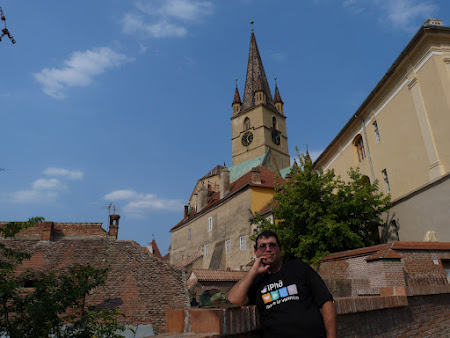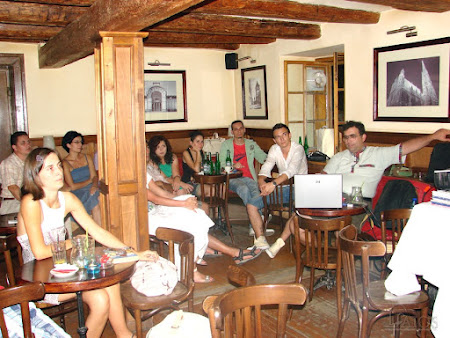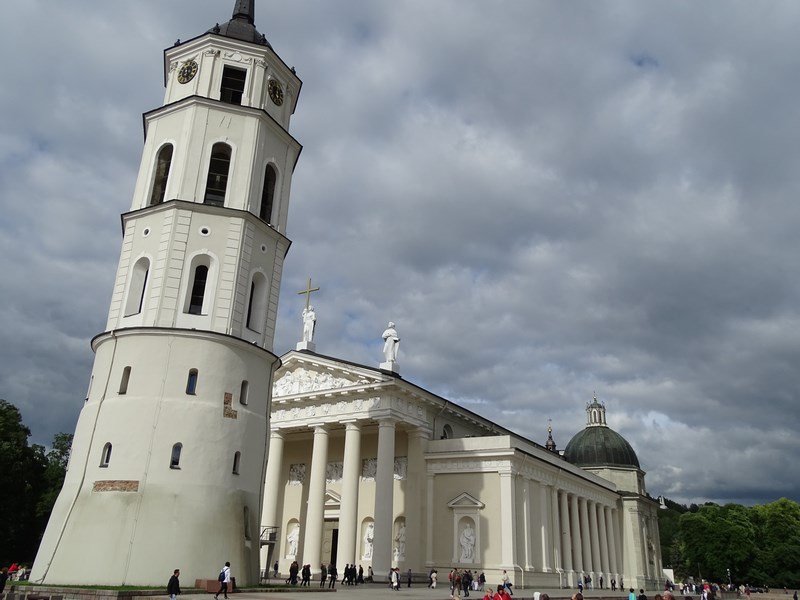A Weekend in Sibiu
 To be honest it’s pretty hard to write down my thoughts right now. I don’t usually write my articles while still “fresh in my heart and mind”, I wait a bit longer, so my thoughts, my impressions and my feelings settle down. But now I really cannot avoid writing about the weekend I spent in Sibiu. And not because the other participants to the bloggers trip already filled the internet with the story of our trip to Sibiu, but because I still have a smile on my lips following this weekend, although I traveled for 5 hours and a half by bus coming from Sibiu at 40 degrees (outside) and about 30 (inside). By the way if you plan on going to Sibiu by bus try riding a Fany or Dacos bus, as they have better buses. But let’s not digress.
To be honest it’s pretty hard to write down my thoughts right now. I don’t usually write my articles while still “fresh in my heart and mind”, I wait a bit longer, so my thoughts, my impressions and my feelings settle down. But now I really cannot avoid writing about the weekend I spent in Sibiu. And not because the other participants to the bloggers trip already filled the internet with the story of our trip to Sibiu, but because I still have a smile on my lips following this weekend, although I traveled for 5 hours and a half by bus coming from Sibiu at 40 degrees (outside) and about 30 (inside). By the way if you plan on going to Sibiu by bus try riding a Fany or Dacos bus, as they have better buses. But let’s not digress.
As I was telling you on Friday this weekend, I got invited to Sibiu for the #PrinSibiulMe Project together with some more bloggers throughout the country (I should even mention Bessarabia, because I shared a room with Eugen ). But let’s start with the beginning in a mini-journal.
Friday morning we had the Charles de Gaulle square in Bucharest as a meeting point at 10.30. The plan was to travel by a minibus made available by the sponsor, Citroen. To our general amazement, we all arrived earlier than the mentioned time and we left, curiously enough, at the precise time. It was clear that we were heading towards a German city, as we were starting to have a German behavior even from Bucharest
More than that, the road was empty, the weather was excellent, so we arrived 4 hours earlier than scheduled (well, the schedule was thought with us being late and slow). Well not, at about 2 o’clock we jumped through the doors of the Ibis Hotel Sibiu that expected us with our rooms ready. I received a room on the 13th floor of the hotel , that was actually called 14th, probably to avoid the anxieties of an American tourist…well, just like in the case of some airlines where the 13th row doesn’t exist, neither was a 13th floor in Ibis Hotel Sibiu . Unfortunately the room was facing the road heading towards the exit from Selimbar and not the old town, in order to admire the towers and domes of Sibiu.
Even so, we didn’t waste too much time in the hotel and we headed straight out to the old town (and to tell the truth towards a long-wished-for lunch as well). We walked along the defense walls of the old town and arrived in an area where some Germans carve in wood or stone. These are the so called “traveling craftsmen”, a hundreds years old tradition that required the already qualified apprentices of various crafts, who wanted to become craftsmen with all rights, members of their own guild to travel to other towns than their own and to work there without asking for money, only shelter and food. Well, although it seems archaic, this tradition still exists and Sibiu is the most eastern town to host wandering craftsmen, coming generally from a Germanic region. They live in the “house of craftsmen”, somewhere behind the Evangelist church and work either next to their house or along the walls of the city… there aren’t just craftsmen, but also craftswomen
Obviously it wasn’t my first time in Sibiu. I can brag that I know Sibiu pretty well (especially the old town), which I visited pretty constantly during the last 24 years. But I never had a guide that knew the story behind each house in this town (including the house that was on that particular spot many hundreds of years ago!). More than that, I discovered some pretty obscure corners in the Downtown, the town of craftsmen and of the ordinary people, not the Uptown of the rich, the mayors, barons and the prelates. As it is already very well known, Sibiu was founded by the Germans, the Saxon settlers brought by the kings of Hungary in the 12th and 13th century. For centuries, only the Saxons had the right to own a house in the city, being therefore the sole residents. They hold their rights and fought anyone who wanted to take them away from them, either Hungarians, Austrians, the Turks or Romanians. Only in 1945, the number of the Germans decreased under 50% of the town’s population and now I don’t think they represent more than 3-5 % – despite this fact, the mayor is German and 65% of the seats in the Town General Council are occupied by representatives of the German Forum, and the results are visible… Sibiu is a clean city, restored to its old glory (well, not 100%), has a cultural life that would make proud any city in Central Europe and the groups of foreign tourists stroll around the city (well, they didn’t quite reach the level of hordes like in Prague, Budapest or Salzburg, but it tends to…).
Well, Saturday morning the whole gang followed Razvan with loyalty, who downloaded thousands of information from his brain…so we found out that around the 1300’s, the Saxons had troubles with the lack of storage space of the archives (they wrote down everything that went down in the city!), but also that the Reform in Sibiu happened peacefully by the expulsion of the 4 catholic monk orders in town. But what repeated itself to despair was that various things happened for the first time in Sibiu “on Romanian Ground” (you cannot say Romania because at that time Sibiu was part of either the Hungarian Kingdom or a free-city or of Transylvania Principality or the Habsburg Empire). Honestly, I kept in mind just few of the “first time on Romanian grounds” so I asked Razvan earlier to send me an email…so I found Sibiu is credited with no less than 33 premieres out of which I could mention the first hospital (1292), the first library (1300), the first school (1380), the first printings in Romanian (1544), the first mention of “Romania” (1779, mentioned by the Saxon historian Martin Felmer) or the first Romanian political party (1870).
I obviously wandered through the Small Square and the Large Square, on narrow, medieval streets, to old monasteries. I discovered with amazement a pretty imposing statue of Saint Jan Nepomuk (if you have ever been to Prague, he has the most well-known statue on the Carol Bridge – an ex confessor of the royal family of Bohemia, that was obliged by the king to betray the secret of the Queen’s confession, who was suspected by the King to have extra-conjugal liaisons with handsome knights. Jan Nepomuk refused, so the King ordered him to be thrown in the river Vltava. He was promptly sanctified and his statues proliferated across the catholic world). Before this digression, I was saying that I discovered a huge hidden statue. It’s in the building that’s linked to the Catholic Church in between the Small and the Large Square, in an inner courtyard, surrounded by houses… When the catholic Habsburgs occupied Transylvania (including Sibiu) they have decided to reimpose their religion upon the protestant Saxons – they built the catholic cathedral in the middle of the town, with a monastery attached to it, but also the statue of Jan Nepomuk. But what the Austrians built during the day, the Saxons came at night and destroyed! Eventually with the help of the army the statue was raised in the Large Square, defiant to the Saxons… Eventually, the ones that “took care of it” weren’t the Saxons, but the communists that tore it down in 1948 and moved it by pieces, as it was, to the Brukenthal Museum where it was rebuilt in 1988 and installed in this inner courtyard while still during Ceausescu’s ruling days …obviously, hidden! It was later discussed to be re-erected in the Large Square after the revolution, but because neither the Saxons, nor the Romanians wanted it, on its place stands now the statue of Gheorghe Lazar, while Saint Nepomuk stays hidden behind the walls. It’s worth visiting, it’s one of the most beautiful baroque statues in Romania!
The afternoon was excellent … We took some bikes from Ivelo and headed on the special bikes tracks to the Astra Museum. On this occasion I found out that Sibiu has no less then 54 km of bicycle tracks and most of them are NOT next to the cars lanes…I crossed along some wonderful, quiet green spaces, till next to the Hilton…I was bicycling like in Holland! I visited the park afterwards, I took pictures of the wind mills that are so dear to me, I took another ride with the bicycle and then we came back for dinner in the Old Town.
Sunday morning, a cultural morning. Although some have been out clubbing in the Sibian clubs, almost everybody was at 10 o’clock at the Brukenthal museum… well, the German spirit got to almost all of us. There, we visited the well known museum. Unfortunately I cannot show you pictures because after a stupid order from “upstairs”, says that one isn’t allowed to take pictures in museums without having someone’s, I don’t know who’s, approval (probably the prime minister’s but as we don’t have one…), but instead I can tell you that I found out about the permanent fight of the museum with stupid rules that demand that all the money generated by the museum to be sent centrally, from where they will be returned after all the ministers villas have been built and the electoral flyers have been printed for the Party in command at one point. So, they might never return. Even in this case, the people from Brukenthal developed a range of souvenirs that is unique in Romania – chocolate, Rubik cubes, a wine from the Brukenthal baron and many other memories that in every other country in the world seem normal, but here you can only find them at the museum in Sibiu.
We also visited the Museum of History, hosted by the old Town Hall, a cute museum … obviously combined with an all knowing guide…the Finale was powerful, at the hotel before all the bloggers left when Eugen took out from his undying bag Bucuria candies and de divine Balti wine from Moldova !
If the whole gang left in all directions towards Chisinau, Bucharest, Timisoara, Deva or Medias, well, I stayed in Sibiu. Not necessarily to turn off the lights, but to tell some stories about North Korea, Iran and Syria during a monthly event organized by Tudor – “World Traveler”…so I stayed in Café Wien next to the Evangelist Church till late after midnight talking about trips around the world!
Pictures of Sibiu:
Where the traveling Craftsmen work
Sibiu by night – from the Tower of Council
Our all knowing guide, Razvan Pop
The statue of Saint Jan Nepomuk, hidden in an inner courtyard
Mason elements in secret places
And finally a picture of everybody…or almost everybody.
The heroical finish of the tour
So, during the second day we went bicycling
And we bicycled
This is one of the two museum tomcats – Donatello and Antonello
And the baron’s wine
And when we left we enjoyed some Bucuria from the Republic of Moldova
Sunday afternoon, peaceful, in Sibiu – the Small Square
Or at the Evangelist Cathedral
 And during the evening telling stories about travels around the world!
And during the evening telling stories about travels around the world!













[…] Sibiu […]
[…] A Weekend in Sibiu by Imperator Travel – photos and stories from a weekend in Sibiu […]